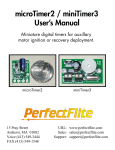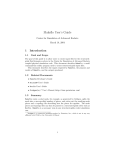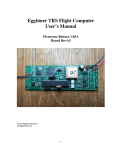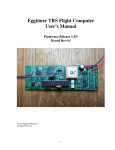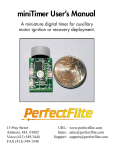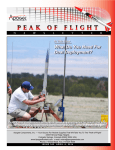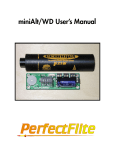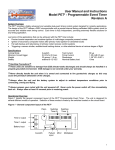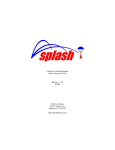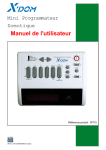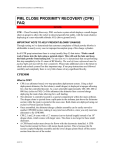Download User Manual - Chute Tamer
Transcript
Chute Tamer™ Recovery Deployment Control User’s Manual Dual Deployment Capability for Your High Flying Single Deployment Rockets *** Achieve, Protect, Recover *** The Chute Tamer™ recovery deployment control is an innovative device that gives you control over your rocket‟s parachute for higher flights and fewer recovery worries! Get the performance that you have been dreaming about out of your existing rockets! Please read these user instructions carefully before attempting to use the Chute Tamer™ control to ensure safe and successful operation. Chute Tamer™ Innovations, LLC www.ChuteTamer.com Email: [email protected] Fax: 440-247-0015 Chute Tamer™ CT4 User‟s Manual © 2006-2007 Warren Farr Page 1 of 11 Features and Benefits Understanding the proper and safe operation of the Chute Tamer™ control is the best way to improve your rocket‟s performance and your enjoyment of rocketry. Bound Parachute– The parachute is folded and bound, unable to deploy until the timer (that you set) expires. The deployed parachute is thus prevented from opening at apogee risking the higher winds aloft and perhaps a long walk, or a lost rocket. Bound Parachute – Because the parachute is bound during motor ejection, it presents a small profile to the air stream. This means less zipper damage should the motor ejection happen too early or too late and when the rocket is traveling at a high velocity. Bound Parachute – Because the parachute is tightly bound before and during motor ejection, it can not unfurl inside the rocket. The bound parachute slides easily out of the rocket‟s airframe ensuring a successful parachute deployment. No Additional Black Powder Charges- The Chute Tamer™ control provides delayed parachute deployment without any explosive black powder charges other than the rocket engine‟s built in ejection charge. The Chute Tamer™ control retrofits into most existing “single deploy” rockets, no isolated altimeter bay, no ematches, and no additional black powder charges are required. Small Size & Light Weight – The Chute Tamer™ control‟s small size allows it to fit into rocket air frames with an inside diameter of 2.1 inches or larger. The Chute Tamer™ control‟s light weight (125 grams, or 4.4 ounces) allows it to be used in most rockets using “F” engine power and above with a minimal reduction in altitude. Audible Feedback Tone – The Chute Tamer™ control provides an audible tone to verify timer and heating element operation. This tone verifies both the timer setting and proper continuity through the heating element. Audible Feedback Tone – The Chute Tamer™ control sounds a loud tone after completing its operation. This tone can be heard from a distance and can be useful in locating your rocket. External Delay Programming – The only reason to open the Chute Tamer™ control is to replace the battery. All essential pre-flight functions: delay time programming and verification, heating element replacement, and turning it on and off are conveniently located on the outside of the device. Delay Time Calculation Worksheet – A simple worksheet, completed by you for each rocket and motor combination ensures quick, reliable, and hassle-free delay time determination. Secure Tether Point- The Chute Tamer™ control has a secure attachment point to connect it securely to your rocket. The Chute Tamer™ control can be easily attached to the rocket‟s existing shock cord or directly to the nose cone eye bolt. Snap-in Heating Element- The modular snap-in heating element design is easy to replace and ensures that the heating element is always in the proper position for binding the parachute. The heating element is encased inside of a modular plug to protect it from damage and to shield it during heating operation. Chute Tamer™ CT4 User‟s Manual © 2006-2007 Warren Farr Page 2 of 11 Chute Tamer™ Operation Installing New Batteries This version (CT4) of the Chute Tamer™ control is a limited production model with a flame retardant plastic enclosure. The enclosure is designed to protect the internal electronics and to provide secure interruption-free battery connections. Care should be taken when opening the enclosure and installing the battery. Photo 1 Photo 2 First, remove the lid by unscrewing the black flat Philips-head screw on the lid side as shown in slide photo 1. The lid is designed to slide off towards the (aft) end of the enclosure once the lid screw has been removed. It is not necessary to completely remove the lid to replace the battery. Slide the lid until the battery is fully revealed (photo 2). Next, remove the battery from its compartment by turning the enclosure over and gently shaking. Unwrap the battery connector leads from around the battery connector. Once unwrapped, the battery connector leads are long enough to allow convenient replacement of the battery (photo 3). Photo 3 Install a new alkaline, lithium, or NiCad 9 volt battery by snapping it onto the battery connector and wrapping the connector leads once around the connector snap. Gently slide the new battery completely into the battery compartment. Finally, slide the lid closed and secure it with the black flat Philips-head lid screws. (If lost, replace the lid screw with a #4-40 by 1/4 inch flat head machine screw.) Tethering the Chute Tamer™ control to Your Rocket The Chute Tamer™ control can easily be hung from the rocket‟s forward section (nose cone) in a position that does not significantly change the relationship between the rocket‟s center of gravity (CG) and its center of pressure (CP). CAUTION: Mounting the Chute Tamer™ control too low in the rocket‟s air frame may cause the rocket‟s center of gravity to move aft of the rocket‟s center of pressure. This can cause a previously stable rocket to become unstable. A good rule of thumb is to measure the rocket‟s center of gravity before installing the Chute Tamer™ control and then hang the Chute Tamer™ control from the nose of the rocket at or forward of the original center of gravity. Ideally, you do not want to significantly change the relationship between center of gravity and center of pressure for a previously well designed rocket. Chute Tamer™ CT4 User‟s Manual © 2006-2007 Warren Farr Page 3 of 11 The Chute Tamer™ control comes with a D-link connector for easy attachment. Simply connect the D-link to an existing quick-link at the rocket‟s nose cone as shown in photo 4. This tethering method will place the added weight of the Chute Tamer™ control close to the rocket‟s nose. Optionally, a loop can be sewn or tied into the recovery harness at a point lower in the rocket‟s airframe to preserve the original CG/CP relationship. This tethering method may be useful for taller rockets. Calculating the Delay Time – This manual contains a Chute Tamer™ Delay Estimator worksheet and a Chute Tamer™ Terminal Tumble Velocity Estimation table. With these sheets and some basic information about your rocket and motor, you can accurately estimate the desired delay time. To do this, you will need the following information: Rocket Information Air frame outside diameter (inches) Air frame length (inches) Weight of rocket with parachute (ounces) Desired delayed parachute deployment altitude (feet) Engine Information Weight of empty engine casing (ounces) Thrust burn time (seconds) Engine delay time (seconds) Expected peak altitude for this rocket/engine combination (feet) Start at the top of the Chute Tamer™ Delay Estimator worksheet (cell “A”) and work your way down the sheet inserting the required information or performing the required calculations. Once you have calculated the Rocket‟s Effective Surface Area {C} and Combined Weight (G), you can calculate the Terminal Tumbling Velocity (H) using the formula shown, or estimate it by looking it up on the Chute Tamer™ Terminal Tumble Velocity Estimation table. Known exceptions: If the terminal tumbling velocity is above 50 feet per second, a drogue parachute should be included in the rocket‟s recovery. (The added drag and stability of the drogue slows the tumbling descent velocity and adds greatly to recovery safety.) A smaller parachute can be tethered to the Chute Tamer™ CT4 User‟s Manual © 2006-2007 Warren Farr Page 4 of 11 Photo 4 rocket and left unbound (not tied to the Chute Tamer™ control). The engine‟s ejection charge will deploy both the drogue parachute (immediate) and the bound main parachute (delayed). When using a drogue parachute, the drogue‟s effective surface area should be compared to the Rocket‟s Effective Surface Area {C} on the worksheet. If the drogue‟s effective surface area is smaller than or equal to the rocket‟s effective surface area, then add the two together and use the sum in the terminal velocity calculation. If the drogue‟s effective surface area is greater than the rocket‟s effective surface area, then use the drogue‟s effective surface in the terminal velocity calculation. If the rocket has multiple air frame sections that are different diameters, calculate the effective surface area for each of the sections and then add them together. The effective surface area of extremely large “wings” or fins can be partially added to the effective surface area of the rocket‟s air frame, taking into consideration that as the rocket tumbles, the wings will present a variable profile to the air-stream (untested). The worksheet has three identical boxes for three different engines to be used in this rocket. If you are using an estimated altitude calculated without the added weight of the Chute Tamer™ control, subtract 100 feet from the expected altitude due to the added weight of the Chute Tamer™ control. Decide what altitude the main parachute should be deployed. Add up the delay time (from launch to parachute deployment). It is that simple! If you are uncertain about the exact timer delay, just use a shorter delay time until you have some launch experience with this engine and rocket combination. It is better to have the parachute open a bit early, than too late. In either case, the parachute will open later than it would have without the Chute Tamer™ control. Setting the Delay Time The Chute Tamer™ control contains a highly reliable digital MT3G MiniTimer made by PerfectFlite. The best way to understand setting the delay time is to read the PerfectFlite manual included with your Chute Tamer™ control. A brief sequence of operations follows: Setting the Delay Time: 1. Turn the Chute Tamer™ control off. Delay Set 2. Press and hold the Delay Set button marked “Delay Set” (photo 5). You should be able to feel the button “click” when you depress it. 3. While depressing the delay set button, turn on the Chute Tamer™ control. You should hear a continuous tone. If not, repeat from step one above. 4. Release the delay set button. Chute Tamer™ CT4 User‟s Manual © 2006-2007 Warren Farr Page 5 of 11 Photo 5 5. Press and hold the delay set button for the total desired Chute Tamer™ delay time. (A watch with a second hand is a great way to measure the desired time.) 6. Release the delay set button at the end of the desired delay time. 7. The Chute Tamer™ control will sound a long tone followed by a sequence of short tones representing the programmed time delay in tenths of a second. (Five tones followed by two tones is 52 tenths of a second, or 5.2 seconds. Ten tones represents a zero value.) The Chute Tamer™ control remembers the most recently programmed time, including after being turned off and after a battery change. Inserting and Verifying the Heating Element Photo 6 The Chute Tamer™ control‟s heating element simply snaps into the matching opening directly below the On/Off switch (photo 6). Orient the modular retaining tab up towards the On/Off switch. To remove the heating element, hold the Chute Tamer™ control in one hand while grasping the heating element modular plug between the thumb and index finger of your other hand. Use your pointer finger to depress the modular retaining tab while pulling the heating element out of the Chute Tamer™ control body. The heating element can be verified as operational by listening for the continuity tone that occurs after the time delay setting is verified during the timer‟s power up sequence. After the delay time is sounded out with short tones, a high-low tone will occur while the timer begins operation. If the heating element is intact, then the high-low tone will be replaced by a high-high tone. If the high-low tone goes silent, then the timer circuit is not able to verify continuity through the heating element. In this case, the rocket should not be launched until the Chute Tamer™ control‟s heating element is replaced and verified. Installing the Monofilament Line The Chute Tamer™ control uses a monofilament line that is strong enough to bind the parachute in a tight bundle, but is easily melted and cut by the heating element. Fishing line has been supplied with your Chute Tamer™ control. Fishing line that is 8 to 15 pound test has been used successfully. Photo 7 Remove the heating element from the Chute Tamer™ control. Insert the monofilament line into the round hole on one side of the heating element so that it goes up and out of the square opening in the top of the heating element. Then insert the monofilament line back down into the square opening in the top of the heating element and out of the round hole on the other side of the heating element. 1 Chute Tamer™ CT4 User‟s Manual © 2006-2007 Warren Farr 2 Page 6 of 11 Photo 8 Photo 9 3 Bringing the monofilament line up through the opening in the base ensures that the line will rest on top of the heating element and NOT below it. When installed properly, the heating element is designed so that under tension, the line will rest in contact with the heating element wire. Good contact is required to insure a quick and clean cut of the monofilament line. Now install the heating element into the Chute Tamer™ control and place it on a flat surface with the heating element side down. You are now ready to fold and bind the parachute to the Chute Tamer™ control. Folding and Binding the Parachute There are many ways to fold and pack a parachute. The way described below has worked well for previous Chute Tamer™ control flights. Before folding the parachute, it is helpful to sprinkle it with some baby powder (this aides in opening the tightly bound parachute once it is released). Start by laying the parachute out on a flat surface, folded in half with all shroud lines below the parachute. Continue to fold the parachute into smaller wedge shaped sections until it is just big enough to fold the shroud lines up and down on top. Leave enough shroud line hanging off of the bottom of the parachute to attach it to the rocket (photo 10). Now fold the tip of the parachute wedge down (once or more depending on parachute size). Finally, starting on the right or left, roll the parachute tightly to form a cylinder. Place the parachute cylinder on the battery cover side of Chute Tamer™ with the shroud lines emerging upwards (end with the D-link). Photo 11 Pull the monofilament lines from the previous step up and around the parachute to bind it. Tie a secure knot so that the parachute is bound tightly (photo 11). (Monofilament line can be difficult to tie securely as it is prone to forming slip knots. Use three or four overhand knots minimum.) Some tension on the line provides good contact with the heating wire and allows the parachute to “pop” open when the line is cut. Excess line can be cut and removed. Please dispose of excess line responsibly. Chute Tamer™ CT4 User‟s Manual © 2006-2007 Warren Farr Page 7 of 11 Photo 10 A Word About Engine Sizing Rocket engines should always be sized to safely lift the rocket off the launch pad. This means that the rocket must achieve a suitable speed for stable flight before leaving the guiding launch rod or rail. A general rule of thumb to calculate the minimum safe motor size is to provide a 5:1 average engine thrust to rocket weight ratio or better. This means that the engine‟s average thrust should be five or more times the weight of the rocket. Rockets are usually weighed in grams, ounces, or pounds. Rocket engine thrust is usually measured in Newtons. (One Newton equals 0.225 pounds equals 3.6 ounces equals 102 grams.) The weight of the Chute Tamer™ control will add to the overall weight of your rocket and require slightly more average engine thrust than the same rocket flown without the Chute Tamer™ control. The weight of the Chute Tamer™ control (about 4.4 ounces), requires an extra 6 Newtons of average thrust (4.0 ounces / 16 ounces per pound* 4.45 pounds per Newton * 5 ratio). Remember to always include the weight of the Chute Tamer™ control in your minimum engine sizing calculations. Example: A rocket weighs 37 ounces without the Chute Tamer™ control. The minimum average engine thrust at five times the rocket‟s weight is 51.4 Newtons (37 ounces / 3.6 ounces per Newton * 5 ratio). This implies that an F52 engine (average engine thrust of 52 Newtons) is sufficient for this rocket without the added weight of the Chute Tamer™ control. Adding the Chute Tamer™ control adds an additional 4.4 ounces to the total rocket weight (41.4 ounces). The minimum average engine thrust at five times the rocket‟s new weight is 57.5 Newtons (41 ounces / 3.6 ounces per Newton * 5 ratio). This implies that an F52 engine is no longer sufficient to launch this rocket safely. But, a G64 engine would provide the necessary average thrust to launch safely. At the Launch Pad The Chute Tamer™ control contains a G switch that detects rocket launch and starts the timer. The switch must experience 0.5 seconds of acceleration of two G‟s or more to be activated. It is recommended that the Chute Tamer™ control be turned off until the rocket is ready to be placed on the launch pad. This will avoid an unwanted activation of the G switch prior to launch and conserve battery life. Range Safety Officers or even Launch Control Officers have been known to shake rockets to test the fit of nose cones, etc. Turning the Chute Tamer™ control on at the launch pad will avoid a premature cutting of the monofilament line. !!! Do not forget to turn the Chute Tamer™ control ON and to listen for the heating element continuity tone before leaving the launch pad! Chute Tamer™ CT4 User‟s Manual © 2006-2007 Warren Farr Page 8 of 11 Testing the Chute Tamer™ Control Outside Your Rocket The Chute Tamer™ control can be “live” tested outside of the rocket‟s airframe. It is highly recommended that you perform a test of the Chute Tamer™ control if you are uncertain of the strength of your battery. This is especially true on cold weather days (below 40 degrees Fahrenheit ground temperature) when the operation of the heating element can be affected. Photo 12 To perform a test, prepare the Chute Tamer™ control as in the above steps, but do not install it into the rocket airframe. The heating element should be installed and the main parachute should be bound to the Chute Tamer™ control. Turn the Chute Tamer™ control on and wait for the continuity tone. Now hold the Chute Tamer™ control in one hand so that the Dlink point towards you (photo 12). Extend your arm out straight up towards the sky and then swing your extended arm down in a 180 degree arc out away from you and then towards the ground (photo 13). Photo 13 The arc should take about one second to complete and must generate the required 2 G‟s of acceleration to activate the timer. You will know that you are successful if the timer‟s continuity tone has stopped. If the continuity tone is still sounding, then the timer has not detected a launch. Try swinging your arm in an arc again. Once the tone has stopped, the timer has begun counting down. Hold the Chute Tamer™ control by the D-link and wait for the timer to expire. At timer expiration, the heating element will be activated and the monofilament line will be cut releasing the parachute. It is normal for the heating element to burn through (like a fuse) rendering it unusable. Heating elements are likely to work for only a single use, especially during warm weather conditions. If the heating element does not burn through, you should be able to see the nichrome wire in the heating element glow red for a second or so. If you do not see a good red glow, then it is time for a new battery. Chute Tamer™ CT4 User‟s Manual © 2006-2007 Warren Farr Page 9 of 11 Cautions Do not install Chute Tamer™ below the original center of gravity of the rocket. This will lower the rocket‟s center of gravity, possibly making the rocket unstable. Do not touch or hold the heating element when the timer is active. The heating element reaches temperatures over 300 degrees F. Small, but severe burns could occur. Replace the battery and/or heating element when required. Failure of Chute Tamer™ (no main parachute release) will cause the rocket to hit the ground at maximum tumbling velocity, possibly causing damage to the rocket, people, and objects on the ground. Terminal tumbling velocity should be less than 50 feet per second through the addition of an unbound drogue parachute, when required. The fit of the rocket‟s nose cone should not be too loose. Because Chute Tamer™ slides easily inside the rocket‟s air frame, quick engine deceleration (engine burnout) could cause Chute Tamer™ to move upwards inside of the rocket body. If rocket deceleration is severe, Chute Tamer™ could lift off the rocket‟s nose cone during flight, prior to engine ejection. The fit of the nose cone should pass the ”shake test” whereby the prepared rocket is turned upside down and shaken lightly. The rocket‟s nose cone should stay on during this test. Quick Operational Checklist 1. Replace the battery if necessary. 2. Calculate the desired parachute deployment delay and program the timer. 3. Thread the monofilament line through the heating element. 4. Fold and bind the parachute. 5. Attach the parachute AND the Chute Tamer™ control to the rocket. 6. Turn the Chute Tamer™ control on and listen for the continuity tone. 7. Keep rocket pointed upwards, do not shake. 8. Launch! Specifications (See PerfectFlite miniTimer User‟s Manual for additional specifications) Dimensions: 5”L x 1.25”W x 1.25”H Weight: 4.4 oz (including 9 volt alkaline (heaviest) battery) Battery: one 9 volt alkaline, lithium, or NiCad battery Trigger: 2 G switch, normally open Timing Range: 0.6 to 6553.5 seconds in 0.1 second steps Timing Accuracy: +/- 3% typical Operating Temperature: 0°C to 70°C Chute Tamer™ CT4 User‟s Manual © 2006-2007 Warren Farr Page 10 of 11 Inventor’s Message The hobby of model and high power rocketry is an outstanding way to have fun and learn at the same time. When guidelines are understood and followed, rocketry is also one of the safest hobbies due to the outstanding efforts of organizations such as the National Association of Rocketry (www.nar.org), and Tripoli Rocketry Association (www.tripoli.org). To get the most out of this hobby, I urge you to join one or both of these organizations and familiarize yourself with their published safety guidelines as well as the many clubs, launches, contests, and more that membership provides. The driving force behind the invention of the Chute Tamer™ control was safety. Today‟s powerful and exciting rocket engines and the general lack of public access to huge open fields causes the safety conscious rocketeer to fly rockets well below their potential in an effort to avoid dangerous recovery situations as well as a potentially lost rocket. It is my greatest hope that the availability of the Chute Tamer™ control to rocketeers around the world, will add greatly to the safety and satisfaction of this hobby. Fly „em high! Warranty This version of Chute Tamer™ (CT4) is warranted to be free of manufacturing defects for one year from the date of purchase. Any serious difficulties with this product should be emailed to [email protected] immediately. Defective products will be repaired or replaced by ChuteTamer Innovations free of charge with the exception of postage on the return of the defective product. Liability Due care has been employed in the design and construction of this product so as to minimize the dangers inherent in its use. As the installation, setup, preparation, maintenance, and use of this equipment is beyond the control of the maker, the user accepts sole responsibility for the safe and proper use of this product. The principle, employees, and vendors of the maker shall not be held liable for any damage or claims resulting from any application of this product. If the user of this product is not confident in their ability to use it in a safe manner, it should be returned to the maker immediately. Any use of this product signifies acceptance of the above terms by the user. ********************************************************************************************** Chute Tamer™ CT4 User‟s Manual © 2006-2007 Warren Farr Page 11 of 11











